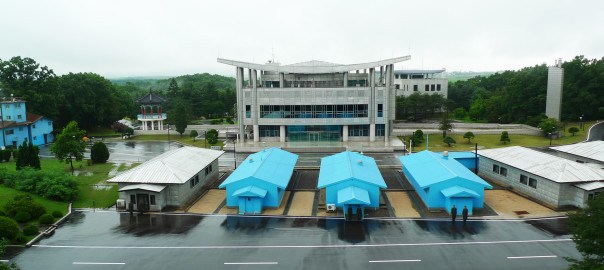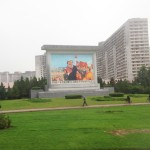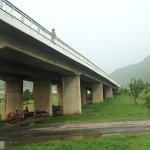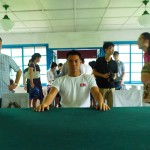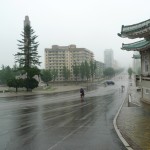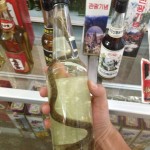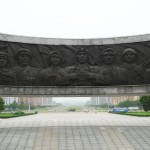Day 4: A full tour day in North Korea starting with the Korea DMZ, the ancient capital Kaesong, watching a student play, and ending with a visit to the Monument to the Founding of the Korean Workers’ Party and the Juche Tower.
We were on time for breakfast today and the food was the same as before with the addition of a delicious pastry.
With everyone on the bus, we left on time towards the Demilitarized Zone. We made one stop at a road-side rest stop for the bathroom and, surprise, they also sold souvenirs. Once we passed through the city Kaesong, we were warned not to take any pictures of the military or they would board the bus and perform an inspection. The whole drive in the rain took about 3 hours.
Korea Demilitarized Zone (DMZ)
At the first checkpoint, we slowed down and were waved through. At the second checkpoint, the tour guide had to get off and register inside the outpost. On her return, we drove through the gates.
We all got off the bus in this courtyard and went into this reception for an introduction of the grounds. A soldier and a Chinese translator explained what we would see using a large wall map. I asked about the black “x” in the map and was told that it indicated where the ‘event’ occurred. This refers to the Axe Murder Incident when two US soldiers were killed in 1976.
Adjacent to the room of the map was a tourist shop with some nice gifts.
Then we lined up and had to walk through a gate while our bus drove through. We got back into the bus, joined by the soldier guide. We were on a very confined road just barely two lanes with high walls. There were large concrete blocks held by steel wire on both sides of the wall that could fall into and block the road if the wires were cut.
We drove to a building and all went inside. This was where the talks occurred for the cease fire. The officer explained where the US, China and North Korean representatives sat. The room was quite small and the furniture was the original.
Then we went to the North Korea Peace Museum which is where the Korean War Armistice Agreement was signed in 1953. The weapons used to kill the US soldiers in the Axe Murder Incident are also showcased in the museum.
With our military guide, we took our bus to next stop, the Joint Security Area. With a small parking lot, we entered the North Korean building, Panmungak. This large building faced the border and South Korean Freedom House. Looking over at the South Korean building, helped put into perspective that we indeed did NOT have any freedom.
Both sides had plenty of video cameras pointing at each other. From the terrace we had a panoramic view of the area including the flags from both countries. Some tourists offered cigarettes to the soldiers in return for pictures with them.
We then went downstairs and lined up in two rows. We marched to a memorial slab that represented the ceasefire.
Then we were on the ground floor where the soldiers stood guard. We weren’t allowed down the step and after some pictures we went back through the building to the buses. It was interesting to note that as soon as we walked in they guards quickly turned the lights back on, but the lights weren’t working…
We left after dropping off the military guide and headed to the next stop.
Kaesong
For lunch, we drove to the nearby city which use to be the capital of Korea during the Koryo Dynasty. The restaurant was small but the food was some of the best we had on the trip. Their speciality was serving in copper dishes. We had a large selection of dishes, including rice, a soup and soju.
The restaurant of course had two souvenir shops which I skipped to check out the street of the restaurant. It was up the hill and quite a distance from the intersection. I heard the propaganda blasting from some speakers below. The guides were staring at me, so I returned to the restaurant courtyard. There were also three “World Food Programme” cars parked there.
Koryo Museum
The bus then took us to Koryo Museum which is a part of a UNESCO World Heritage Site. Another traditionally dressed guide, took us through the grounds to see a few old buildings with traditional roofs. Inside we saw different relics, many of which were replicas. It wasn’t particularly interesting, though historically significant.
In the parking lot were two large stores selling souvenirs. They had stamps, postcards and paintings. We picked up a few items.
We then headed back to Pyongyang, passing through the Monument to Three Charters for National Reunification also known as the Reunification Arch. The guide asked us what differences we saw from the two women holding hands forming the arch. “Nothing” was the answer, “the Korean people are one.”
North Korean School Performance
Our next stop was the student performance near Mansudae. At the entrance there were students outside standing with their red scarves and blue dresses greeting and taking pictures with tourists.
It was open seating and a few other tour groups were there. The show was a series of performances with mostly dancing and singing. One show had girls dancing on roller-skates and another with vases on their heads. The estimated age was between 5 and 12.
It was about an hour long and the performances were quite flawless. Reminiscent of the Arirang Festival, the dancers were very well practiced which would make one question how ‘volunteer’ the whole after school activity was.
At the end of the show, we could take pictures with the girls with permanent smiles and give flowers or gifts. We finally gave away the candies we bought in Dandong that we’ve been carrying around.
Whether forced or voluntary, they put on a laudable show that could only be attained with much practice.
Monument to the Founding of the Korean Workers’ Party
We went to the statue of the hands holding the hammer, paintbrush, and sickle, which represent the workers, intellectuals and peasant respectively.
Another clone guide in a traditional dress greeted us and took us around the monument. We didn’t pay too much attention as the photo-ops were too good.
Then we went to see what a real “government building” looked liked. It turned out to be a giant tourist shop… a fitting end to the building tours.
On the walk back to the bus our guide pointed out that this area was a place that people relaxed and enjoyed the park. A guy playing with his kid just happened to speak in fluent Chinese. Two students suspiciously “studying” in the courtyard kept watching us in the corner of their eyes. Everything seemed so staged that it was uncomfortable.
For dinner we went to the nearby embassy area for Korean hotpot.
Each person got an individual hotpot that we lit ourselves. Instead of broth the base was water and we had the option to add salt, pepper, MSG, and spices. We each had a big plate of meat and vegetables to add to the hotpot. This was accompanied by some hot dishes of vegetables with tofu and a cold beer. It was very appetizing and we ate way more than we should have…
Downstairs was another souvenir shop, but we could also wait outside next to the bus. Some of the tourists went around the corner to take pictures and a random couple walking down the street stared, then stopped and whispered into our guide’s ear. Immediately after the guide waved the guys over and told everyone to get back on the bus. It seems that everyone on the street is observing us.
Juche Tower
Our last stop for the day was the tower with a red flame at the top representing Kim Il Sung’s ideology. Completed in 1982, it is the second tallest column in the world and modeled after the Washington Monument. Apparently we could go to the top of the tower, but not at this hour. In front was a statue of three people holding the hammer, sickle, and paintbrush.
Dusk approached and we could barely make out the shapes of the military guards at the base of the stairs when we were exploring. We hesitated to go further as our guide was not with us.
When the rest of the group caught up, some tourists walked too far down the stairs and the soldier started blowing his whistle. Our guide then seemed very anxious and herded everyone back into the bus.
Yanggakdo Hotel
Getting back to the hotel, we wanted to explore the extra activities offered, as it was our last night. We walked around for a bit until we finally found the activity floor which was down the stairs from the main lobby.
There were many activities available such as table tennis, billiards, bowling, karaoke, a shoeshine, hairstylist, and swimming pool. However, the staff were not very friendly and the facilities were very old and worn.
We decided to go to the revolving restaurant for a drink on our last night. We bumped into three guys from our tour and sat with them over a beer. We shared our thoughts and ideas over the past two days. Everyone was more relaxed and at ease, but we were still cautious with what we said as we were not out of North Korea yet.
As it was past midnight, we headed back to our room. After a shower, we watched a bit of TV on the one North Korean channel before falling asleep.
Tomorrow, we get our passports back (hopefully).
